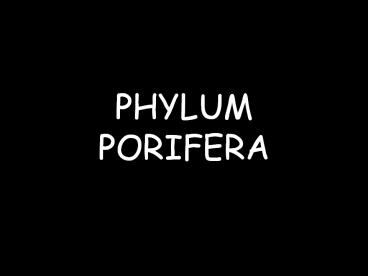PHYLUM PORIFERA - PowerPoint PPT Presentation
Title:
PHYLUM PORIFERA
Description:
Phylum Porifera- Syconoid Type Sponge: a longitudinal & cross-sectional view. ... These are examples of the most complex sponge type. The choanocytes ... – PowerPoint PPT presentation
Number of Views:804
Avg rating:3.0/5.0
Title: PHYLUM PORIFERA
1
PHYLUMPORIFERA
2
Phylum Porifera- Asconoid Type Sponge
This simplest sponge type has its choanocytes
located in its spongocoel. Note buds (asexual
reproduction) and many oscula (plural of
osculum) on this slide. fig 1.3-A
3
Phylum Porifera-Asconoid Type Sponge note
spicules, spongocoel, osculum bud fig 1.3-A
4
Phylum Porifera- Asconoid Type Sponge
This simplest sponge type has its choanocytes
located in its spongocoel. Its also a small
sponge type. fig 1.3-A
5
Phylum Porifera- Syconoid Type Sponge
An example of a syconoid-type sponge.This sponge
type has its choanocytes located in its radial
canals. Note the prominent spicules fig 1.4
6
Phylum Porifera-Syconoid Type Sponge
A
a longitudinal cross-sectional view. Note
the osculum (A), spongocoel, radial canals
the choanocytes lining the radial canals. A
magnified view of a radial canal showing
individual choanocytes is included. fig 1.4
7
Phylum Porifera-Syconoid Type Sponge (CS)
This is a close-up of a cross-section through the
radial canals of a syconoid-type sponge. Note the
radial canals, the choanocytes lining canals,
osculum fig 1.4
8
Phylum Porifera- Leuconoid Type Sponge
These are examples of the most complex sponge
type. The choanocytes are located in the many
flagellated chambers. Any large sponge is most
likely a leuconoid- type sponge.































